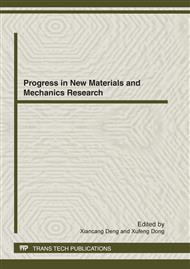[1]
Collins M A. Carbon Dioxide Enhanced Oil Recovery Mechanism and engineering design [M]. Beijing: Petroleum Industry Press, (1989).
Google Scholar
[2]
Liu Feng. Ultra-heavy oil emulsion viscosity reduction technology Research [J]. Special oil and gas reservoirs, 2005, 12 (2): 82 ~ 84.
Google Scholar
[3]
Dong of the Beijing, the new Mu Lung. Domestic heavy oil cold production technology status and development trend [J]. Drilling Technology, 2002, 25 (2): 18 ~ 22.
Google Scholar
[4]
Diao factors, Puwan Fen, Lin Bo, etc. from the raw heavy oil reservoir interior of CO2 stimulation techniques [J]. Special oil and gas reservoirs, 2005, 12 (6): 98 ~ 101.
Google Scholar
[5]
GUMERSKY KH KH, DZHAFAROV IS, et al In-Situ generation of carbon dioxide: new way to increase oil re-covery [R]. SPE65170, (2000).
DOI: 10.2118/65170-ms
Google Scholar
[6]
Luo Ruilan, CHENG Lin-song. CO2 injection adaptability of heavy oil reservoirs [J]. Oil Drilling Technology, 2004, 26 (5): 67 ~ 72.
Google Scholar
[7]
LI Zhen quan. Phase behaviors of light oil with dissolution of CO2 Under reservoir conditions [J]. Journal of the Petroleum, China. 2004, 28 (3): 43 ~ 45.
Google Scholar
[8]
Song Dan, Puwan Fen, XU Xiaofeng, etc. from the raw CO2 flooding technology system and the effects of flooding [J]. Oil Drilling Technology, 2007, 29 (2): 82-85.
Google Scholar
[9]
Anthony R Kovacek. Mechanistic foam flow simu-la-tion in heteroneneous and multidimensional porousmedia [J]. SPE 39102, (1997).
Google Scholar
[10]
Yuan Shiyi, Liushang Qi, Zhang Yitang so. Adding nitrogen foam flooding water increase heavy oil recovery research [J]. . 2004, 25 Petroleum Technology (1): 57 ~ 62.
Google Scholar
[11]
Lvguang Zhong, Zhang Joe nitrogen bubble of hot water flooding to improve heavy oil recovery technology research [J]. . 2005, 27 Oil and Gas Journal (2): 387 – 389.
Google Scholar
[12]
Li Z.Q., Zheng S.S., Hu Y., Tao Q.G., He W, Failure Modes-Based Multi-levels Optimization Design of Structures, IEIT Journal of Adaptive & Dynamic Computing, 2011(4), Oct 2011, pp: 1-8. DOI=10. 5813/www. ieit-web. org/IJADC/2011. 4. 1.
DOI: 10.5813/www.ieit-web.org/ijadc/2011.4.1
Google Scholar
[13]
M.P. Vani, Computer Aided Interactive Process of Teaching Statistics Methodology – III Evaluation Questionnaire for LearnersThrough statistical display using Bar chart, IEIT Journal of Adaptive & Dynamic Computing, 2011(4), Oct 2011, pp: 9-14. DOI=10. 5813/www. ieit-web. org/IJADC/20114. 2.
DOI: 10.5813/www.ieit-web.org/ijadc/2011.4.2
Google Scholar


